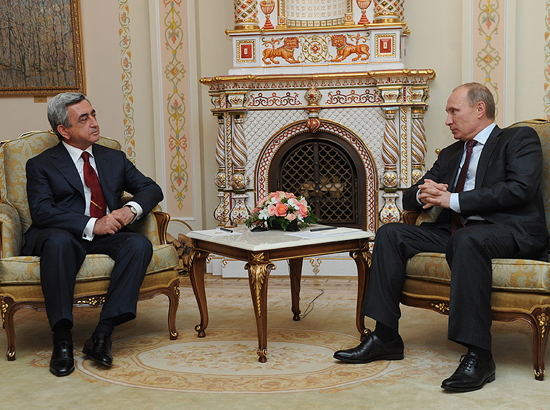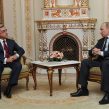
Implications of Armenia’s Russian and Eurasian Choice
Publication: Eurasia Daily Monitor Volume: 10 Issue: 157
By:

President Serzh Sargsyan has decided that Armenia should join the Russia-led blocs, the Customs Union and the Eurasian Union, as part of a deal with Russian President Vladimir Putin. Sargsyan unveiled this decision to his own country from Moscow, alongside Putin, on September 3, and has not yet commented about it within Armenia as of September 5. If this choice stands, it would amount to turning down Armenia’s agreements with the European Union on association, free trade and visa liberalization, which were due to be concluded in November at the summit in Vilnius (see EDM, September 5).
The implications extend from Armenia’s agitated domestic politics, to South Caucasus geopolitics, Russian-EU relations, and the European and US political arenas via influential Armenian diaspora groups (see below).
In Yerevan, senior figures from the governing Republican Party and even the Ministry of Foreign Affairs were surprised by Sargsyan’s announcement and reacted in confusion. The main source of surprise is not Sargsyan’s decision as such, nor the terms in which he framed it, but its timing and the secretiveness of the process that led up to it. Some observers conjecture whether Sargsyan had made this decision in Yerevan and then took it to Moscow, or was ambushed and pressured or cajoled by Putin into choosing Russia over Europe.
Some Republican Party politicians are lining up behind Sargsyan, arguing that Armenia’s membership in the Customs Union and prospectively in the Eurasian Union had already been in the works and that it meets Armenia’s national interests. Initial reactions from within the Republican Party and allied politicians seek to de-dramatize the situation and head off possible anti-government protests by pro-European groups. These are individual voices thus far; the governing party as such has not yet spoken.
The Armenian National Congress, a vocal opposition party, is also biding its time. However, several pro-European personalities (formerly top government officials) from this party have criticized Sargsyan’s Moscow deal as contravening Armenia’s interests and its sovereignty. Prosperous Armenia, a larger but tame quasi-opposition party, seems altogether silent. The entire body politic awaits overdue clarifications from the head of state (PanARMENIAN.Net, Arminfo, Tert.am, ArmeniaNow, RFE/RL, September 4, 5).
The hardline nationalist Armenian Revolutionary Federation (ARF-Dashnaktsutiun) became the first party officially to endorse Sargsyan’s apparent deal with Putin. According to the ARF Supreme Council’s resolution, the overall geopolitical situation and Armenia’s security interests require its accession to the Customs Union and later Eurasian Union, initiated by “Armenia’s strategic ally” [Russia]. However, the ARF faults Sargsyan for not consulting with political parties and the public in advance of the decision. Dashnaktsutiun demands guarantees for Armenia’s and Karabakh’s security and economic development, in return for Armenia’s accession to the Russian-led economic bloc. The Dashnak resolution does not specifically name Russia as a provider as such guarantees, but it blatantly means Russia (Asbarez, September 4). Considering the Dashnaks’ history and the specific electorate of this party, the ARF must find it hard to embrace Moscow suddenly and openly.
Awaiting Sargsyan’s clarifications, a fairly common assumption holds that Armenia’s “security situation” has caused the president to concede to Putin’s terms. It implies trading Armenia’s European option for a “Eurasian” option, in hopes of ensuring Russian protection of Armenia vis-à-vis Azerbaijan. The ARF-Dashnak resolution has clearly read this tradeoff into the Sargsyan-Putin agreement.
This concept is not a novel one at its core. Russia had, de facto, protected Armenian territorial gains at Azerbaijan’s expense following the 1994 ceasefire. This was followed by the 1997 Russia-Armenia bilateral alliance treaty, 2006 declaration on allied cooperation, and the 2010 prolongation of Russia’s basing rights in Armenia until 2044. In the last few years, however, a successful Azerbaijan has grown stronger than stagnant Armenia, while Russia is now supplying arms to both countries (at discounted prices or even gratis to Armenia; at market prices to Azerbaijan). The unresolved conflict stifles Armenia’s development, but Yerevan holds on to the occupied territories and has in that sense become hostage to its illusory gains. It now risks becoming even more of a hostage to Russia for preserving those gains a while longer within a Eurasian construct.
European Union officials in Brussels and leading proponents of the EU’s Eastern Partnership are aghast at Russia’s bold move. They describe Putin’s procedure as “open blackmail” and as a move hostile to Europe, designed to sabotage the November 2013 Vilnius summit. But they also tend to regard Sargsyan as a less-than-innocent casualty (EU Observer, RFE/RL, BNS, September 3, 4).
Brussels and other European capitals are concerned about the possibility of a “domino effect” resulting from the Kremlin’s seemingly successful move to shift Armenia’s orientation from Europe to Russia and Eurasia in one fell swoop. This success could embolden Moscow and supportive groups in Ukraine or Moldova to attempt replicating such a move in those countries. European and American diplomats are actively engaging with the governments in Kyiv, Chisinau and Tbilisi to ensure that the association, free-trade, and visa liberalization agreements between these countries and the European Union are successfully concluded at the Vilnius summit.




